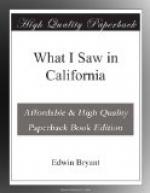CHAPTER XVIII.
Route by land
Outfit, etc., and advice to intending
Emigrants.
The route via Independence or St. Joseph, Mo., to Fort Laramie, South Pass, Fort Hall, the Sink of Mary’s River, etc., etc., the old route. Let no emigrant, carrying his family with him, deviate from it, or imagine that he can find a better road. This road is the best that has yet been discovered, and to the Bay of San Francisco and the Gold Region it is much the shortest. The Indians, moreover, on this route, have, up to the present time, been so friendly as to commit no acts of hostility on the emigrants. The trail is plain and good where there are no physical obstructions, and the emigrant, by taking this route, will certainly reach his destination in good season and without disaster. From our information we would most earnestly advise all emigrants to take this trail, without deviation, if they would avoid the fatal calamities which almost invariably have attended those who have undertaken to explore new routes.
The lightest wagon that can be constructed, of sufficient strength to carry 2500 pounds’ weight, is the vehicle most desirable. No wagon should be loaded over this weight, or if it is, it will be certain to stall in the muddy sloughs and crossings on the prairie in the first part of the journey. This wagon can be hauled by three or four yokes of oxen or six mules. Oxen are usually employed by the emigrants for hauling their wagons. They travel about 15 miles per day, and, all things considered, are perhaps equal to mules for this service, although they cannot travel so fast. They are, however, less expensive, and there is not so much danger of their straying and of being stolen by the Indians.
Pack-mules can only be employed by parties of men. It would be very difficult to transport a party of women and children on pack-mules, with the provisions, clothing, and other baggage necessary to their comfort. A party of men, however, with pack-mules, can make the journey in less time by one month than it can be done in wagons—carrying with them, however, nothing more than their provisions, clothing, and ammunition.




